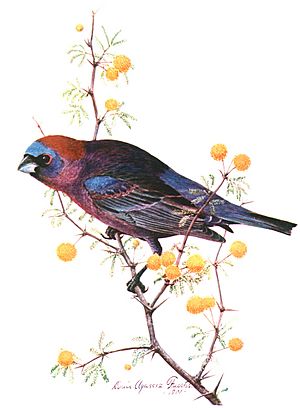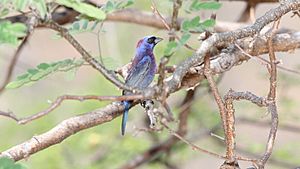Varied bunting facts for kids
Quick facts for kids Varied bunting |
|
|---|---|
 |
|
| Male | |
| Conservation status | |
| Scientific classification | |
| Genus: |
Passerina
|
| Species: |
versicolor
|
 |
|
The varied bunting (Passerina versicolor) is a small, colorful songbird. It belongs to the Cardinalidae family, which includes cardinals and grosbeaks. These birds are known for their beautiful songs and bright feathers.
Contents
Where Do Varied Buntings Live?
Varied buntings live in warm regions. Their main home stretches from the southern parts of the United States (like Arizona, New Mexico, and Texas) all the way south through Mexico to Oaxaca. You can also find smaller groups of them in Chiapas, Mexico, and in southeastern Guatemala.
These birds prefer dry, thorny places. They like deserts and xeric shrublands, especially areas with thick, thorny bushes, thorn forests, and scrubby woodlands. They also enjoy overgrown clearings where they can find food and shelter.
What Do Varied Buntings Look Like?
Varied buntings are stocky birds with short tails and rounded bills. They are about 11 to 14 centimeters (4.3 to 5.5 inches) long. Their wingspan is around 21 centimeters (8.3 inches), and they weigh about 11 to 13 grams (0.39 to 0.46 ounces).
Male and Female Varied Buntings
Male and female varied buntings look quite different:
- Males: Breeding males are very striking. They have feathers that are purple-red all over. They also have a bright red patch on the back of their neck, called the nape. In the fall, their colors become a bit browner.
- Females: Females are much plainer. They are a light brown color. They look a bit like female indigo buntings, but they do not have streaks or stripes on their chest.
What Do Varied Buntings Eat?
Varied buntings are busy eaters. They look for their food on the ground. Their diet includes:
Varied Bunting Life Cycle and Nests
Varied buntings are careful builders when it comes to their homes. They weave their nests into an open-cup shape. They use grass and spider webs to make them strong. These nests are usually found in the outer branches of thorny bushes, often close to water.
Eggs and Young Birds
Female varied buntings lay two to five eggs. The eggs are usually bluish-white or bluish-green. The mother bird sits on the eggs to keep them warm, a process called incubation. This takes about 14 days.
Once the chicks hatch, they grow quickly. They are fully feathered, meaning they have all their feathers, after about 10 days. A few days after that, they are ready to leave the nest and start exploring on their own.
See also
 In Spanish: Colorín oscuro para niños
In Spanish: Colorín oscuro para niños
Images for kids





